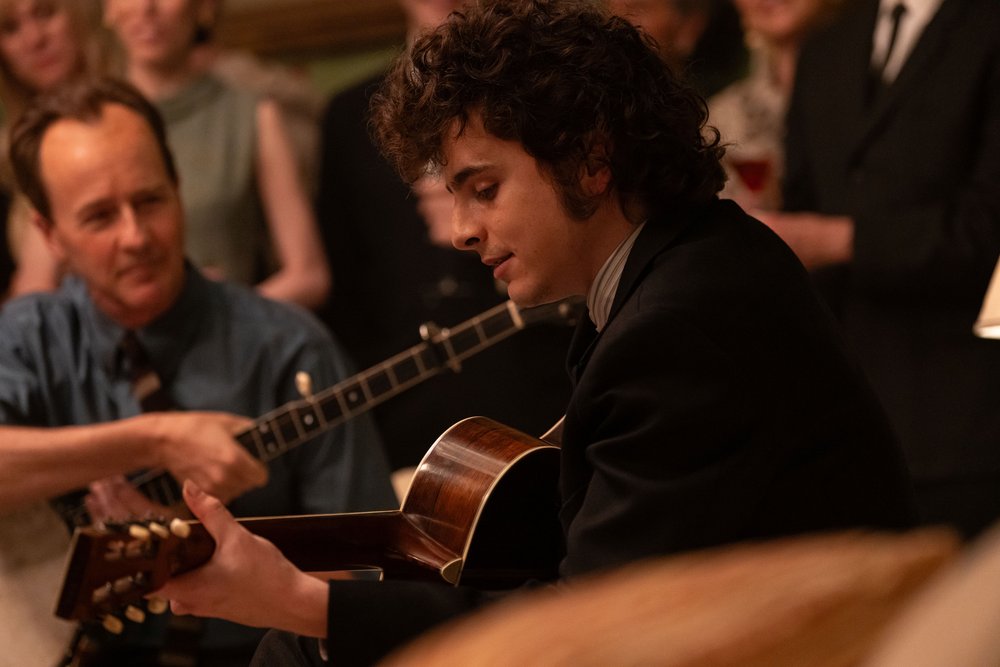
Photos by Macall Polay, Courtesy of Searchlight Pictures
A COMPLETE UNKNOWN– 4 STARS
After a hearty two-hour-plus running time, the very last song Timothée Chalamet’s Bob Dylan recreates on stage in A Complete Unknown is the very first public performance of “Like a Rolling Stone” for tens of thousands gathered at the now-infamous 1965 Newport Folk Music Festival. By this point, Dylan is at the peak of his storied powers as a songwriter and folk artist. For James Mangold’s film, this is the title-announcing climax set to bring the house down.
And, how was that organ-infused rock song received by the hootenanny faithful? Wouldn’t you know it, it was showered with scoffing boos, flipped lids, and backstage fisticuffs. How’s that for a big ending to a movie?
LESSON #1: THE “ELECTRIC DYLAN” CONTROVERSY– Why, do you ask? It’s because Bob Dylan brought electric instruments to the Newport Folk Music Festival, a place where he had been cherished for years with other folk music loyalists standing on stage with nothing but his acoustic guitar, harmonica, and biting lyrics. By plugging an electric guitar into an amplifier and bringing pianist Barry Goldberg and members of the Paul Butterfield Blues Band to back him, Bob Dylan broke the rules in folk’s Mecca. Bob Dylan changed the flavor of the music to his—and its own—benefit, which becomes the true summation point of A Complete Unknown.
What’s crazy is that viewers watching this finale of A Complete Unknown are likely having the total opposite reaction to the depicted Newport crowd. As surviving beatniks and casual music lovers may remark, “Like a Rolling Stone” is, by several accounts, the singer’s greatest and most influential single. This is the performative triumph scaffolded for Chalamet all movie long, and we’re watching trash thrown at him while tapping our toes and smiling from ear to ear.
Two hours earlier in A Complete Unknown, we are introduced to Timothée’s embodiment pre-stardom. In 1961, the man born Robert Zimmerman hitchhiked from Minnesota to New York City with a backpack and a guitar case to meet his hero Woody Guthrie (Scoot McNairy, recently seen in Nightbitch), medically muted and crippled by Huntington’s disease at Greystone Park Psychiatric Hospital in New Jersey. Beside next to Guthrie was his protege and Red Scare investigation target Pete Seeger (three-time Academy Award nominee Edward Norton, who’s good enough for his fourth here). Playing for an audience of two, “Bobby” was looking to “maybe catch a spark” and had a song he wanted to play for Woody. That spark brought lightning to Seeger and Guthrie, and they knew it on the spot.
LESSON #2: THE POWER OF A GOOD SONG– Taking Dylan under his wing and roof for a time, Pete Seeger would call “Song to Woody,” a “hell of a song,” which, by the end of A Complete Unknown, would stand in contrast to the loathesome reception given to “Like a Rolling Stone” and Pete’s own testifying mantra of “A good song can only do good.” That’s not always the case, and this dichotomy speaks to the confluence of intention and impression with art. Who is impressed by your work? What crowd or attention did you target or attract? Furthermore, from a sustainability standpoint, is anyone buying your art? Chalamet’s own words as Dylan when answering the question of who he wants to be to his potential sweetheart Sylvie Russo, played by Elle Fanning as a proxy for Freewheelin’ Bob Dylan covergirl Suze Rotolo, after sharing a matinee show of Now, Voyager are simply “a musician who eats.” On top of that, the most significant answer-stamping line later becomes “It’s gotta be good for somebody.”
It would be easy to say “the rest was history” in A Complete Unknown, knowing Dylan’s cornerstone prominence in the Greenwich Village arts scene how lauded his highly lionized career would be with presidential-level awards and the honor of being the first musician to win the Noble Prize in Literature. However, Bob Dylan’s upward trajectory was not immediate, and Mangold’s film stays in those formative years between 1961 and 1965. Marketed as a new, younger face for folk by Seeger and super manager Albert Grossman (Dan Fogler of the Fantastic Beasts series), Bob was stuck playing repertoire selections and not his originals until a boost of popularity came from collaborating on and off the mic with celebrated star Joan Baez (Top Gun: Maverick cast member Monica Barbaro). That juice lifted his second Freewheelin’ Bob Dylan album to hit status, gained him a pen pal friend in Johnny Cash (transformed professional movie villain Boyd Holbrook), and raised his public profile to celebrity status.
LESSON #3: TRUE PERFORMANCES ALWAY BEAT POST-PRODUCTION ENHANCEMENTS– Throughout A Complete Unknown, one of the most exceptional qualities is the cascading talent displayed by the cast members commissioned to play musical performers. Chalamet, Norton, Barbaro, and Holbrook all sang and performed their own numbers with period-accurate instruments and equipment, uncanny emulation, and no earpieces on set. Motivated by the work of Austin Butler in Elvis to hire Bob Marley: One Love movement coach Polly Bennett and Butler’s vocal coach Eric Vetro and dialect coach Tim Monich, Chalamet himself performed over 40 songs during the production. Barbaro is especially incredible as Baez’s classic songbird. All combined, their commitment added to their character creations stupendously, and two-time Oscar-nominated cinematographer Phedon Papamichael’s camera makes them look like they walked out of archival footage in sterling brilliance.
If there is a portion of persona skimped—for the lack of a better word—from A Complete Unknown, it is the rabble-rousing history of Bob Dylan as the activist branded by his own music. Those tales could fill several biopics and never have a recreated stage or recording studio performance. His musical responses and protest songs for facism, the Cold War, Civil Rights movement and more created a different kind of ego from the typical big star, but Mangold’s film only hints at those mindsets and impacts and briefly floats the “contrarian” label. Even with a handful of questioning peers, there’s not really a villain in the picture. Led by Norton’s Pete Seeger, it’s all pride brimming from a group of like-minded artists making music for same righteous reasons.
Adapting the 2015 book Dylan Goes Electric! Newport, Seeger, Dylan, and the Night That Split the Sixties by Elijah Wald, the team of Silence writer Jay Cocks and director James Mangold knew full well one film couldn’t capture the entirety of Bob Dylan. Focusing on more music than protest made for a greater entertaining experience without losing enigmatic intrigue. The prevailing fascination of both admiration and jealousy shown in these early years surrounds the question of where do the untamed lyrics of the “mysterious minstrel” come from. Everyone wonders while Dylan goes on scribbling notes and recording one heart-stirring jolt after another. By the end, the music purposely becomes the point of contention, not divisive politics.
Unlike other biopics which love to end on jubilant peaks of superstardom, A Complete Unknown rests on the aforementioned anti-victory of a future greatest hit met with fan derision. That contemptuous exclamation point couldn’t be more appropriate for the main subject. At that time, misunderstood fans didn’t know what they had—and still have with the man still writing songs and touring today in his 80s. Thanks to the sensational flair of Chalamet and Barbaro crooning and swooning, A Complete Unknown won’t let old purists and new fans make that previous mistake. They’re going to remember this film as the place they caught their own spark. Hell, they might even make a hootenanny of their own out of it!









LOGO DESIGNED BY MEENTS ILLUSTRATED (#1253)
from Review Blog https://ift.tt/2g6HG0K







No comments:
Post a Comment